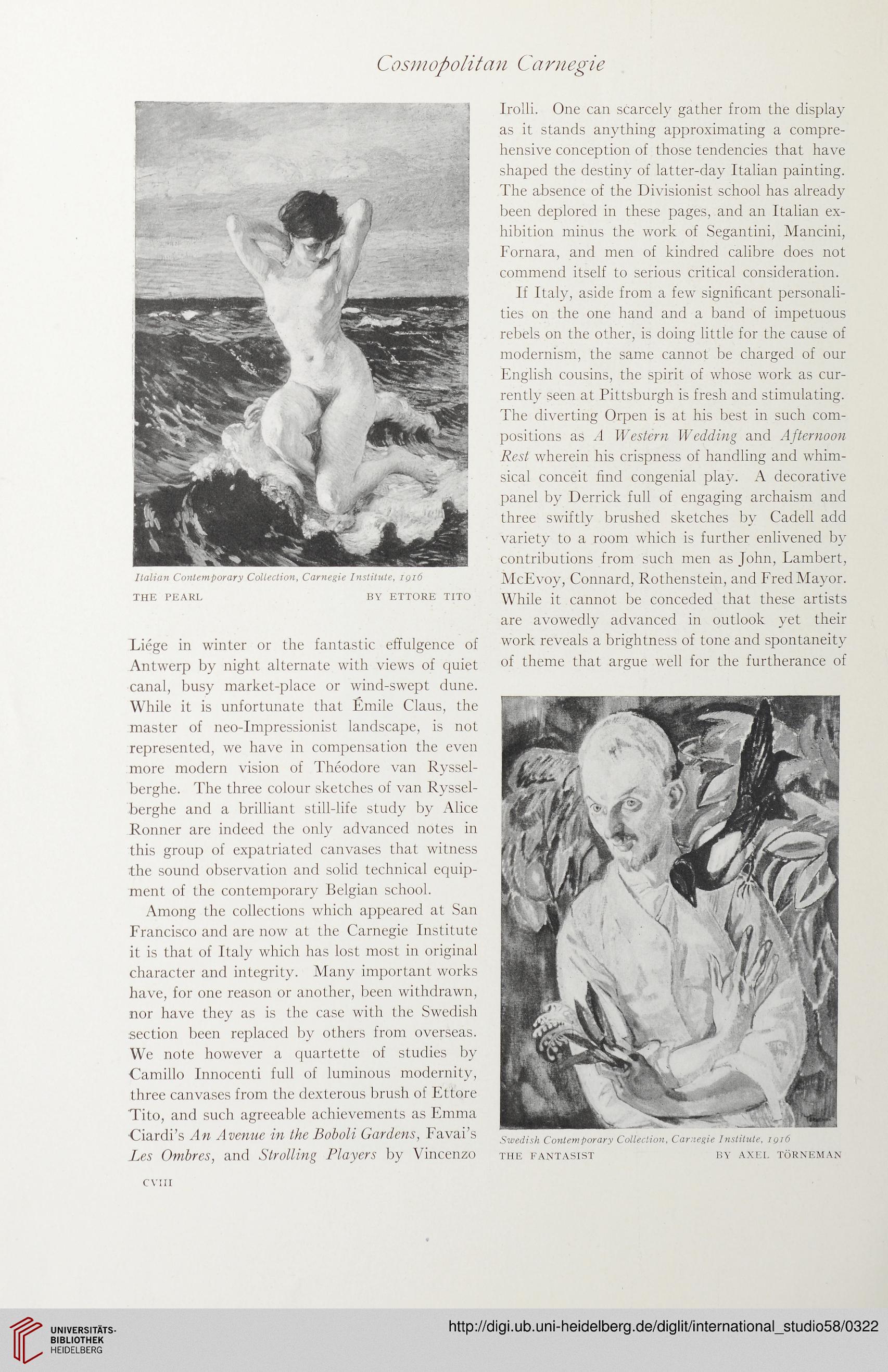Cosmopolitan Carnegie
■ . > <
Italian Contemporary Collection, Carnegie Institute, igi6
THE PEARL BY ETTORE TITO
Liege in winter or the fantastic effulgence of
Antwerp by night alternate with views of quiet
canal, busy market-place or wind-swept dune.
While it is unfortunate that Emile Claus, the
master of neo-Impressionist landscape, is not
represented, we have in compensation the even
more modern vision of Theodore van Ryssel-
berghe. The three colour sketches of van Rvssel-
berghe and a brilliant still-life study by Alice
Ronner are indeed the only advanced notes in
this group of expatriated canvases that witness
the sound observation and solid technical equip-
ment of the contemporary Belgian school.
Among the collections which appeared at San
Francisco and are now at the Carnegie Institute
it is that of Italy which has lost most in original
character and integrity. Many important works
have, for one reason or another, been withdrawn,
nor have they as is the case with the Swedish
section been replaced by others from overseas.
We note however a quartette of studies by
Camillo Innocenti full of luminous modernity,
three canvases from the dexterous brush of Ettore
Tito, and such agreeable achievements as Emma
Ciardi’s An Avenue in the Boboli Gardens, Favai’s
Les Ombres, and Strolling Players by Vincenzo
Irolli. One can scarcely gather from the display
as it stands anything approximating a compre-
hensive conception of those tendencies that have
shaped the destiny of latter-day Italian painting.
The absence of the Divisionist school has already
been deplored in these pages, and an Italian ex-
hibition minus the work of Segantini, Mancini,
Fornara, and men of kindred calibre does not
commend itself to serious critical consideration.
If Italy, aside from a few significant personali-
ties on the one hand and a band of impetuous
rebels on the other, is doing little for the cause of
modernism, the same cannot be charged of our
English cousins, the spirit of whose work as cur-
rently seen at Pittsburgh is fresh and stimulating.
The diverting Orpen is at his best in such com-
positions as A Western Wedding and Afternoon
Rest wherein his crispness of handling and whim-
sical conceit find congenial play. A decorative
panel by Derrick full of engaging archaism and
three swiftly brushed sketches by Cadell add
variety to a room which is further enlivened by
contributions from such men as John, Lambert,
McEvoy, Connard, Rothenstein, and Fred Mayor.
While it cannot be conceded that these artists
are avowedly advanced in outlook yet their
work reveals a brightness of tone and spontaneity
of theme that argue well for the furtherance of
Swedish Contemporary Collection, Carnegie Institute, 1916
THE FANTASIST
BY AXEL TORNEMAN
CVIII
■ . > <
Italian Contemporary Collection, Carnegie Institute, igi6
THE PEARL BY ETTORE TITO
Liege in winter or the fantastic effulgence of
Antwerp by night alternate with views of quiet
canal, busy market-place or wind-swept dune.
While it is unfortunate that Emile Claus, the
master of neo-Impressionist landscape, is not
represented, we have in compensation the even
more modern vision of Theodore van Ryssel-
berghe. The three colour sketches of van Rvssel-
berghe and a brilliant still-life study by Alice
Ronner are indeed the only advanced notes in
this group of expatriated canvases that witness
the sound observation and solid technical equip-
ment of the contemporary Belgian school.
Among the collections which appeared at San
Francisco and are now at the Carnegie Institute
it is that of Italy which has lost most in original
character and integrity. Many important works
have, for one reason or another, been withdrawn,
nor have they as is the case with the Swedish
section been replaced by others from overseas.
We note however a quartette of studies by
Camillo Innocenti full of luminous modernity,
three canvases from the dexterous brush of Ettore
Tito, and such agreeable achievements as Emma
Ciardi’s An Avenue in the Boboli Gardens, Favai’s
Les Ombres, and Strolling Players by Vincenzo
Irolli. One can scarcely gather from the display
as it stands anything approximating a compre-
hensive conception of those tendencies that have
shaped the destiny of latter-day Italian painting.
The absence of the Divisionist school has already
been deplored in these pages, and an Italian ex-
hibition minus the work of Segantini, Mancini,
Fornara, and men of kindred calibre does not
commend itself to serious critical consideration.
If Italy, aside from a few significant personali-
ties on the one hand and a band of impetuous
rebels on the other, is doing little for the cause of
modernism, the same cannot be charged of our
English cousins, the spirit of whose work as cur-
rently seen at Pittsburgh is fresh and stimulating.
The diverting Orpen is at his best in such com-
positions as A Western Wedding and Afternoon
Rest wherein his crispness of handling and whim-
sical conceit find congenial play. A decorative
panel by Derrick full of engaging archaism and
three swiftly brushed sketches by Cadell add
variety to a room which is further enlivened by
contributions from such men as John, Lambert,
McEvoy, Connard, Rothenstein, and Fred Mayor.
While it cannot be conceded that these artists
are avowedly advanced in outlook yet their
work reveals a brightness of tone and spontaneity
of theme that argue well for the furtherance of
Swedish Contemporary Collection, Carnegie Institute, 1916
THE FANTASIST
BY AXEL TORNEMAN
CVIII




